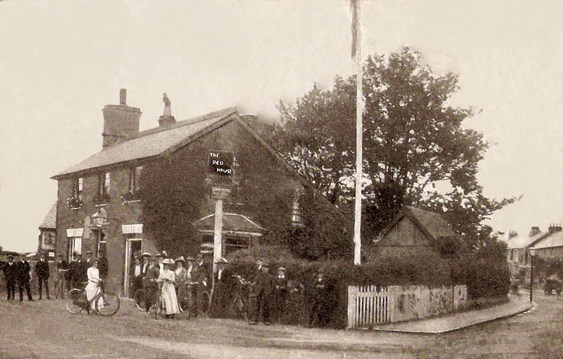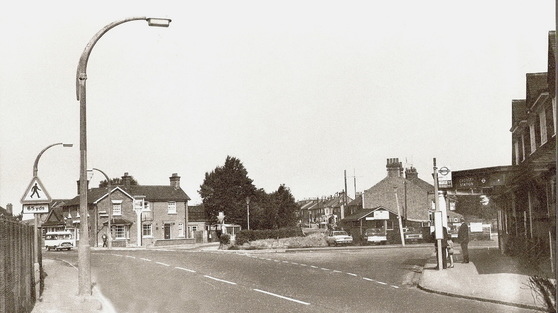The Red House - Watford Road
Probably named about 1870 when the Watford Road was part of the Hatfield to Reading turnpike road. Many long distance travellers using this highway would take advantage of the opportunity to stop here as it provided luncheons, dinners and teas. Pleasure grounds and gardens were also advertised. One of the earliest brewers to supply the public house was Sedgwick’s Ales and Stouts.
During this time and up to the mid 1920’s the immediate area was still open farm land and John Dickinson provided a large area of this land opposite the pub for use by the village for recreational use. When the Metropolitan railway was extended from Moor Park to Watford Park via Croxley Green this land was required and the sports ground moved to its present site off The Green.
This hostelry was also a good location providing the mill workers and narrow boat ‘bargees’ with refreshments after a long working day. The narrow boats originally hauled by heavy horses were used for transporting goods on the canal. They were often seen escorted up Mill Lane for overnight stabling made available at the public house. Many of the narrow boats calling at the mill either to deliver or collect supplies were affectionately known as ‘The Croxley Dashers’ as speed was of the essence with this service.
There were several flag poles erected around the village about 1900 used as a means of communication as well as raising the Union flag for national events. One of these flagpoles was outside The Red House.
After the 2nd World War until the 1950’s a special Saturday treat was provided by Mr Flack then living in Hazlewood Drive. Having finished his normal week’s work he and a friend would take the earliest Metropolitan train to Billingsgate Fish Market in London and bring back several sack full of shell fish, including whelks and winkles. These would be taken to his home and prepared. A home made ‘coffin-shaped’ barrow on wheels would act as a stall and this would be set up outside the pub for his eagerly awaiting regular customers.
The Red House was also known to have been included in the local pub challenges for various sporting games. The premises have been altered and extended many times since it was built and also offers restaurant facilities.(2015). The current website can be viewed here www.redhouse-croxleygreen.co.uk
During this time and up to the mid 1920’s the immediate area was still open farm land and John Dickinson provided a large area of this land opposite the pub for use by the village for recreational use. When the Metropolitan railway was extended from Moor Park to Watford Park via Croxley Green this land was required and the sports ground moved to its present site off The Green.
This hostelry was also a good location providing the mill workers and narrow boat ‘bargees’ with refreshments after a long working day. The narrow boats originally hauled by heavy horses were used for transporting goods on the canal. They were often seen escorted up Mill Lane for overnight stabling made available at the public house. Many of the narrow boats calling at the mill either to deliver or collect supplies were affectionately known as ‘The Croxley Dashers’ as speed was of the essence with this service.
There were several flag poles erected around the village about 1900 used as a means of communication as well as raising the Union flag for national events. One of these flagpoles was outside The Red House.
After the 2nd World War until the 1950’s a special Saturday treat was provided by Mr Flack then living in Hazlewood Drive. Having finished his normal week’s work he and a friend would take the earliest Metropolitan train to Billingsgate Fish Market in London and bring back several sack full of shell fish, including whelks and winkles. These would be taken to his home and prepared. A home made ‘coffin-shaped’ barrow on wheels would act as a stall and this would be set up outside the pub for his eagerly awaiting regular customers.
The Red House was also known to have been included in the local pub challenges for various sporting games. The premises have been altered and extended many times since it was built and also offers restaurant facilities.(2015). The current website can be viewed here www.redhouse-croxleygreen.co.uk
The Red House as seen from junction with New Road and Watford Road. The Red House public house has one of several flag poles that was used to convey National or interesting news around the village. For example when the annual Oxford and Cambridge boat race was completed an appropriate flag was raised.
Light blue for Cambridge, dark blue for Oxford. One of the boys has a metal hoop - a favourite pastime was to bowl this along with a stick! You can also see that some major building work has taken place to extend the Red House in the two pictures above.
Light blue for Cambridge, dark blue for Oxford. One of the boys has a metal hoop - a favourite pastime was to bowl this along with a stick! You can also see that some major building work has taken place to extend the Red House in the two pictures above.

An accident had occurred on the bend outside the Croxley Green Metropolitan station. One side of the front bumper of the car is damaged – the fate of the casualty from the motorbike is unknown. One of the cottages on the right received a direct hit from an oil bomb during the Second World War which landed in a well in the garden. The cottages were eventually demolished and replaced by several houses on land adjacent to the station car park in the Watford Road. The Red House can be seen in the picture along with the bombed cottage that is missing in the picture below
The Red House public house & Croxley Station - taken after 1949 when the station was renamed Croxley instead of Croxley Green to avoid confusion with the first LNWR line at the junction with Baldwins Lane and Watford Road that still operated at that time. To the left of the station is a wooden hut that was very popular with model makers and sold a variety of materials that would include such items as balsa wood for constructing model aeroplanes. A block of flats eventually replaced it. Unfortunately a gas explosion occurred in the building and it required a re build.
1871 Census
George Wilkins - 60 years born Northamptonshire - Victualler
Mary Wilkins - 61 years born Chesham Bucks - Wife
George Wilkins - 60 years born Northamptonshire - Victualler
Mary Wilkins - 61 years born Chesham Bucks - Wife
1881 Census
Robert Hollidge - 58 years born Beckenham Kent - Licensed Victualler
Jane Hollidge - 59 years born Penge Surrey - Wife
Maria Odell - 51 years born Lewisham Surrey - Border / Widow
Robert Hollidge - 58 years born Beckenham Kent - Licensed Victualler
Jane Hollidge - 59 years born Penge Surrey - Wife
Maria Odell - 51 years born Lewisham Surrey - Border / Widow
1891 Census
Robert Holledge* - 68 years born Beckenham Kent - Inn Keeper (retired 1896)
Maria Holledge* - 61 years born Lewisham Surrey - Wife
(It would appear Jane, Robert's wife has passed away and he has married his boarder)
( * slight variation in surname spelling)
Robert Holledge* - 68 years born Beckenham Kent - Inn Keeper (retired 1896)
Maria Holledge* - 61 years born Lewisham Surrey - Wife
(It would appear Jane, Robert's wife has passed away and he has married his boarder)
( * slight variation in surname spelling)
1901 Census
William W McClew - 37 years born Scotland - Publican
Clara E McClew - 32 years born Dartford Kent - Wife
William R McClew - 9 years born Croxley Green
Isabella G McClew - 8 years born Croxley Green
William W McClew - 37 years born Scotland - Publican
Clara E McClew - 32 years born Dartford Kent - Wife
William R McClew - 9 years born Croxley Green
Isabella G McClew - 8 years born Croxley Green
1911 Census
Eli Bull - 57 years born Eynesbury Huntingdon - Licensed Victualler / Married 37 years
Sarah Ann - 56 years born Marlow Bucks - Wife
Georgina Gurney - 20 years born Hammersmith London - Servant
Eli Bull - 57 years born Eynesbury Huntingdon - Licensed Victualler / Married 37 years
Sarah Ann - 56 years born Marlow Bucks - Wife
Georgina Gurney - 20 years born Hammersmith London - Servant
1921 Census
William Smith - Head b1874 age 47Sussex - Publican
Florence Smith - Wife b1875 age 46 Mile End, London - House Hold Duties
Sarah Harmsworth - Mother b1847 age 73 Sussex
William Smith - Head b1874 age 47Sussex - Publican
Florence Smith - Wife b1875 age 46 Mile End, London - House Hold Duties
Sarah Harmsworth - Mother b1847 age 73 Sussex





















